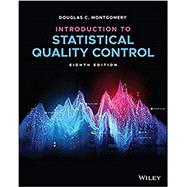Once solely the domain of engineers, quality control has become a vital business operation used to increase productivity and secure competitive advantage. Introduction to Statistical Quality Control offers a detailed presentation of the modern statistical methods for quality control and improvement. Thorough coverage of statistical process control (SPC) demonstrates the efficacy of statistically-oriented experiments in the context of process characterization, optimization, and acceptance sampling, while examination of the implementation process provides context to real-world applications. Emphasis on Six Sigma DMAIC (Define, Measure, Analyze, Improve and Control) provides a strategic problem-solving framework that can be applied across a variety of disciplines.
Adopting a balanced approach to traditional and modern methods, this text includes coverage of SQC techniques in both industrial and non-manufacturing settings, providing fundamental knowledge to students of engineering, statistics, business, and management sciences. A strong pedagogical toolset, including multiple practice problems, real-world data sets and examples, and incorporation of Minitab statistics software, provides students with a solid base of conceptual and practical knowledge.









